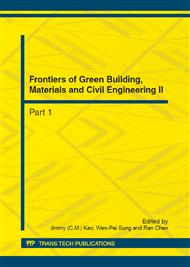p.125
p.129
p.133
p.137
p.142
p.146
p.152
p.157
p.161
Assessment System of Green Building in Chongqing
Abstract:
In the recent twenty years, with the rapid development of china’s economy and city construction, residential projects development becomes more prosperous than ever before. The speed of Chinese Chongqing residential projects development is higher than any period in history. It brings many problems, such as house price went up too quickly, resources consumed over much and so on, due to the development speed was too high and the developers seeking high profit unilaterally. Therefore, we must seek a proper balance between endless requirements and limited resources supply and aim at to construct a keep zoology balance, increase the efficiency of energy and other resource, and share comfortable healthy and most cost-efficient residence as a final goal. Based on previous reasons, the thesis try to provide a basic point for the whole industry to correspond via the evaluation and research on durative of Chongqing residential project, to guide developers to follow a uniform high standard while developing residential projects, heighten the integral level of residence development.
Info:
Periodical:
Pages:
142-145
Citation:
Online since:
August 2012
Keywords:
Price:
Сopyright:
© 2012 Trans Tech Publications Ltd. All Rights Reserved
Share:
Citation:


